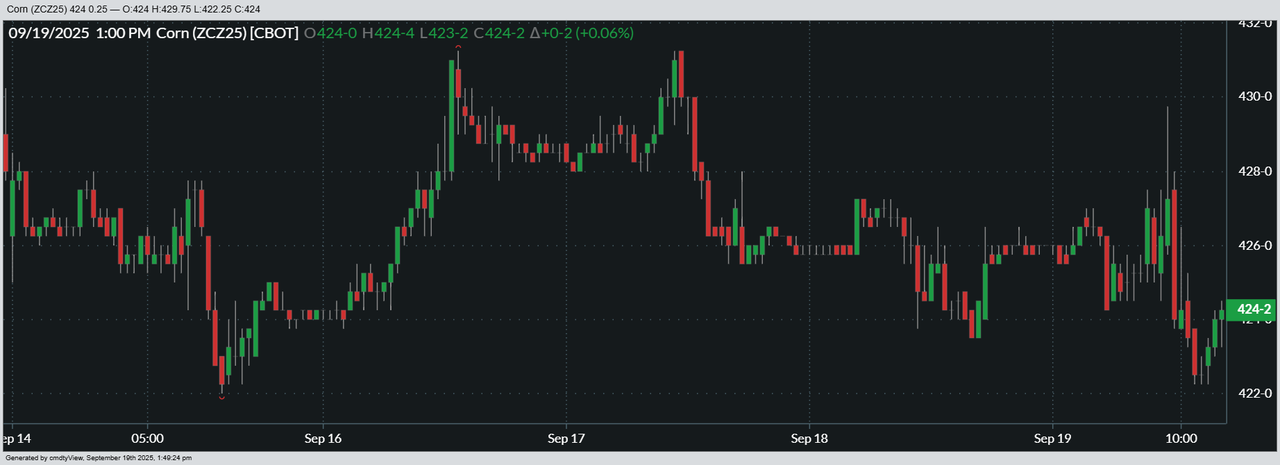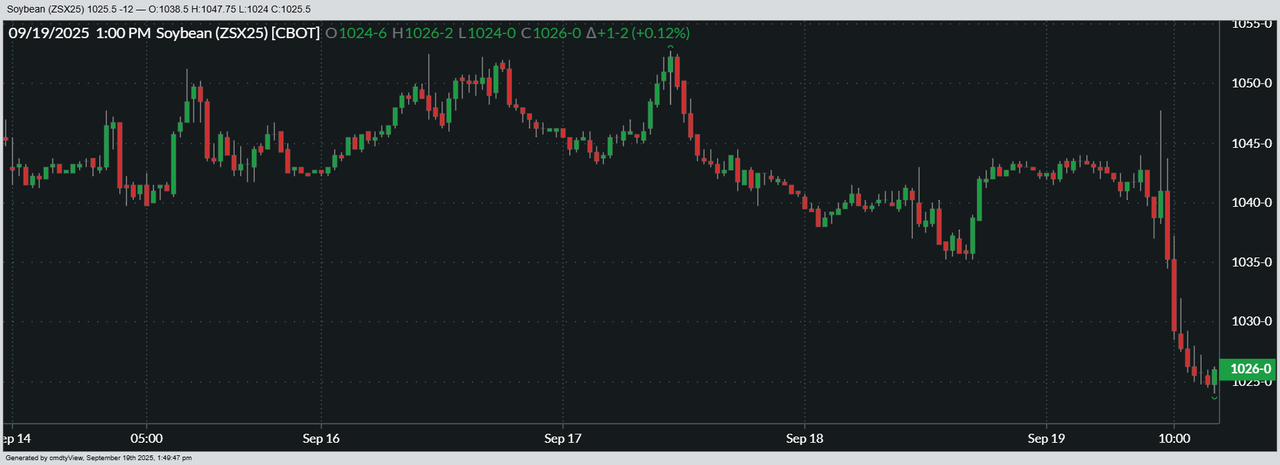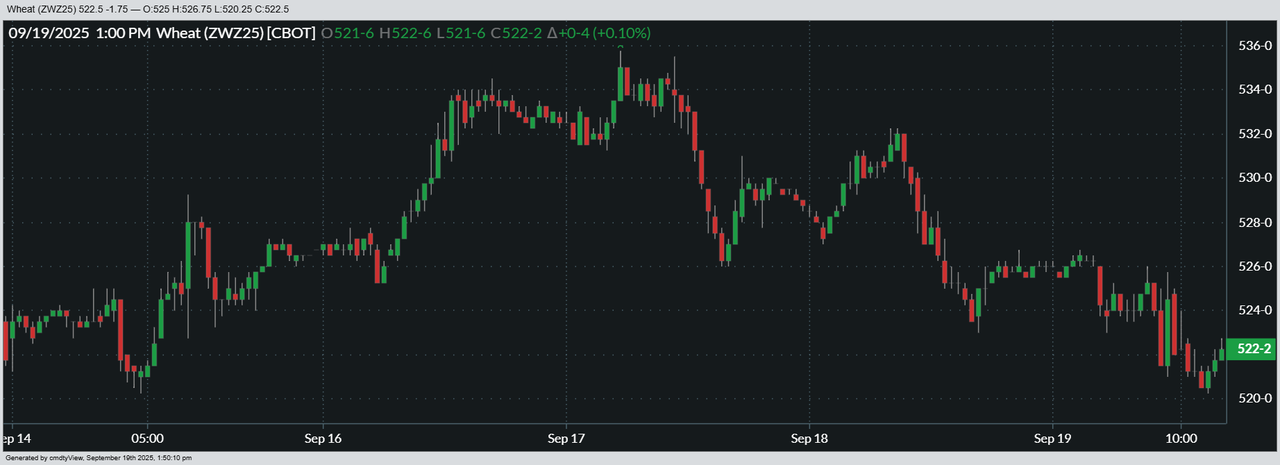Don’t miss the latest market commentary from the Farm Futures team. Sign up for the complimentary morning and afternoon market newsletters!
China is the U.S. soybean farmer’s No. 1 overseas customer by a long shot – at least it was before fresh tariffs ground export sales to a halt. That doesn’t mean good outcomes can’t eventually be had, but it does translate into short-term pain for prices. Soybean futures faced double-digit cuts after talks between Trump and Xi earlier today weren’t thought to be very fruitful. The two will meet in person at the end of October at the APEC Summit in South Korea, and additional phone conversations could happen between now and then. Corn and winter wheat prices also settled lower on Friday.
Variable rains are likely across most of the Corn Belt over the next several days, with chances to get anywhere between trace amounts and 1.5” between Saturday and Tuesday, per the latest 72-hour cumulative precipitation map from NOAA. Later on, NOAA’s new 8-to-14-day outlook predicts seasonally warm, wet weather for most of the Midwest and Plains between September 26 and October 2.
On Wall St., the Dow improved 147 points in afternoon trading to 46,289 – a new record high – as investors appear to remain bullish on the Federal Reserve’s latest interest rate cut earlier this week, with hints that two more cuts will be levied in 2025. Energy futures were in the red, meantime, with crude oil spilling almost 1.5% lower to $62 per barrel. Gasoline futures slumped almost 2% lower. The U.S. Dollar firmed moderately.
Corn prices narrowly mixed in blasé session
Prices weren’t able to move the needle much in either direction on Friday following some mixed technical maneuvering. December futures inched half a penny higher to $4.24, while March futures eased 0.5 cents lower to $4.4125.

Private exporters announced to USDA the sale of 8.1 million bushels of corn for delivery to unknown destinations during the 2025-26 marketing year, which began September 1.
Between July and September, USDA noted major moves in corn production, from a 15.7 billion bushels crop up to 16.8 billion bushels. Over the same period, the agency also upped demand estimates from 15.410 billion bushels to 16.055 billion bushels. Naomi Blohm, senior market adviser with Total Farm Marketing, says current price trends reflect the simple truth that we don’t have a firm grasp on where corn yields will ultimately end up until harvest is complete. “Summer pollination issues and Southern rust may be taking a toll on yields,” she notes. Blohm explores the situation further in yesterday’s Ag Marketing IQ blog – click here to learn more.
U.S. Secretary of Agriculture Brooke Rollins announced that Taiwan has committed to purchasing up to $10 billion in U.S. agricultural products over the next four years, which is approximately 25% above its current purchases of around $2 billion per year. The Taiwan trade delegation signed this letter of intent on Wednesday and specifically targets purchases of U.S. corn, soybeans, wheat and beef.
Corn settlements on Thursday were for 171,045 contracts.
Soybean prices still focused on China absence
Traders returned to a pattern of technical selling that led to double-digit losses heading into the weekend. November futures fell 12 cents to $10.2550, with January futures down 11.75 cents to $10.4450.

The rest of the soy complex also trended lower. October soymeal futures faced fractional cuts, while October soyoil futures eroded more than 1% lower.
President Donald Trump and Chinese President Xi Jinping engaged in trade talks via phone this morning and may meet in person in the coming weeks as the world’s top two economic powerhouses hope to forge a new trade deal. Four rounds of trade talks have now commenced since May. Negotiations will be critical – especially in regards to soybeans because China has still yet to book any new crop sales. China accounted for approximately 45% of all U.S. soybean exports in the 2024-25 marketing year.
Unfortunately, initial reporting suggests today’s talks were not very productive in terms of renewing ag trade. “The fact that there wasn’t any specific ag products mentioned is a disappointment,” said Randy Place, a Hightower Report analyst. “Not anything you could point to, to say we made a breakthrough.”
In a related note, Bloomberg is reporting that as of September 11, China hadn’t booked a single cargo nearly two weeks into the new marketing season – the first time on records going back to 1999. “Beijing, with healthy stockpiles in hand, is signaling it has the patience and capacity to wait — and that it’s willing to use commodities as a bargaining chip in broader trade talks,” according to the article.
Will this ultimately set the stage for more farmer assistance? That’s a question that Farm Progress policy editor Joshua Baethge has been asking. There are several potential avenues to capturing additional aid, but the current environment in D.C. may leave bipartisan solutions hard to come by. Click here to learn more.
Soybean settlements on Thursday were for 156,768 contracts.
Winter wheat prices are still struggling
Prices shifted another 0.25% to 0.5% lower following a round of technical selling on Friday. December Chicago SRW futures dropped 1.75 cents to $5.2250, with December Kansas City HRW futures down 2.75 cents to $5.0725.

European trade association Coceral upped its estimates for combined EU and UK wheat production to 5.416 billion bushels for the current season. That would be a year-over-year increase of 17%, if realized.
And finally, there are strategies you can consider if your family is facing another generational “buyback” of the farm, according to Mike Downey, farm business consultant with Uncommon Farms. In fact, there are six steps that can help support a cost-effective farm succession, he notes. Downey walks through them in his latest More than Dirt blog – click here to learn more.
CBOT wheat settlements on Thursday were for 60,924 contracts.